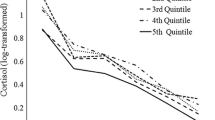Abstract
The current study examined how well affect and daily events predict life satisfaction in 72 college students. Surveys assessing mood, affect balance, health, and sleep quality provided estimates of affect and daily events. The Satisfaction with Life Scale (SWLS) was used as a measure of general life satisfaction. The current results indicated that the SWLS was significantly correlated with feelings of depression, anger, vigor, and confusion, with physical health and frequency of physical illness, with positive and negative affect, and with sleep quality. The predictor variables used in the current study accounted for 54.1% of the total variance of the SWLS. However, only depression, vigor, confusion, frequency of illness and negative affect were significant predictors of life satisfaction in both a standard regression model and in a hierarchical forward regression model. More practically, an increase in subjective life satisfaction was predicted by decreases in depression, decreases in negative affect, decreases in the frequency of illness, and increases in vigor. These results indicate that judgements of life satisfaction, as measured by the SWLS, were significantly predicted by affect and daily events.
Similar content being viewed by others
REFERENCES
Andrews, F. M. and A. C. McKennell: 1980, ‘Measures of self-reported well-being: Their affective, cognitive and other components’, Social Indicators Research 8, pp. 127–155.
Andrews, F. M. and S. B. Withey: 1976, Social Indicators of Well-Being (Plenum Press, New York).
Arrindell, W. A., L. Meeuwesen and F. J. Huyse: 1991, ‘The satisfaction with life scale (SWLS): Psychometric properties in a non-psychiatric medical outpatients sample’, Personality and Individual Differences 12(2), pp. 117–123.
Beck, A.: 1978, Beck Depression Inventory (Center for Cognitive Therapy, Philadelphia).
Bowling A.: 1991, Measuring Health: A Review of Quality of Life Measurement Scales. (Open University Press, Philadelphia).
Bradburn NM.: 1969, The Structure of Psychological Well-Being (Aldine Publishing, Chicago).
Brodman, K., A. J. Erdmann Jr., H. G. Wolff and P. F. Miskovitx: 1986, Cornell Medical Index Health Questionnaire Manual (Cornell University Medical College, New York).
Buysse, D. J., C. F. Reynolds III, T. H. Monk, S. R. Berman and D. J. Kupfer: 1989, ‘The Pittsburgh sleep quality index: A new instrument for psychiatric practice and research’, Psychiatry Research 28, pp. 193–213.
Campbell, A., P. E. Converse and W. L. Rodgers: 1976, The Quality of American Life (Sage, New York).
Chamberlain, K.: 1988, ‘On the structure of subjective well-being’, Social Indicators Research 20, pp. 581–604.
Cohen, J. and P. Cohen: 1983, Applied Multiple Regression/Correlation Analysis for the Behavioral Sciences, 2nd Edition (Lawrence Erlbaum Associates, Hillsdale, New Jersey).
Diener, E. and R. A. Emmons: 1984, ‘The independence of positive and negative affect’, Journal of Personality and Social Psychology 47, pp. 1105–1117.
Diener, E., R. A. Emmons, R. J. Larsen and S. Griffen: 1985, ‘The satisfaction with life scale’, Journal of Personality Assessment 49, pp. 71–75.
Diener, E.: 1994, ‘Assessing subjective well-being: Progress and opportunities’, Social Indicators Research 31, pp. 103–157.
Fordyce, M.: 1986, ‘The Psychap Inventory: A multi-scale test to measure happiness and its concomitants’, Social Indicators Research 18, pp. 1–33.
Hartmann, E., F. Baekeland and G. Zwilling: 1972, ‘Psychological differences between long and short sleepers’, Archives of General Psychiatry 26, pp. 463–468.
Hong, S. and E. Giannakopoulos: 1994, ‘The relationship of satisfaction with life to personality characteristics. The Journal of Psychology 128, pp. 547–558.
Horley, J. and B. R. Little: 1985, ‘Affective and cognitive components of global subjective well-being measures’, Social Indicators Research 17, pp. 189–197.
Kammann, R. and R. Flett: 1983, ‘Affectometer 2: A scale to measure current level of general happiness’, Australian Journal of Psychology 35, pp. 259–265.
Kozma, A. and M. J. Stones: 1980, ‘The measurement of happiness: Development of the memorial university of newfoundland scale of happiness (MUNSCH)’, Journal of Gerontology 35, pp. 906–912.
McKennell, A. C. and F. M. Andrews: 1980, ‘Models for cognition and affect in perceptions of well-being’, Social Indicators Research 8, pp. 257–298.
McKennell, A. C. and F. M. Andrews: 1983, ‘Components of perceived life quality’, Journal of Community Psychology 11, pp. 98–110.
Neto, F.: 1995, ‘Predictors of satisfaction with life among second generation migrants’, Social Indicators Research 35, pp. 93–116.
Neugarten, B. L., R. J. Havighurst and S. S. Tobin: 1961, ‘The measurement of life satisfaction’, Journal of Gerontology 16, pp. 134–143.
Pailhaus, E., O. Benoit, F. Goldenberg, G. Bouard and C. Payant: 1988, ‘Psychological profile and sleep organization in young subjects with poor quality of sleep’, Psychiatry Research 26, pp. 327–336.
Pavot, W. and E. Diener: 1993, ‘Review of the satisfaction with life scale’, Psychological Assessment 5(2), pp. 164–172.
Pavot, W., E. Diener, C. R. Colvin and E. Sandvik: 1991, ‘Further validation of the satisfaction with life scale: Evidence for the cross-method convergence of well-being measures’, Journal of Personality Assessment 57, pp. 149–161.
Pedhazur, E. J.: 1982, Multiple Regression in Behavioral Research: Explanation and Prediction, 2nd Edition (Harcourt Brace, New York).
Pilcher, J. J., D. R. Ginter and B. Sadowsky: 1997, ‘Sleep quality vs. sleep quantity: The relationships between sleep and measures of health, well-being, and sleepiness in college students’, Journal of Psychosomatic Research 42(6), pp. 583–596.
Pilcher, J. J. and E. S. Ott: in press, ‘The relationships between sleep and measures of health and well-being in college students: A repeated measures approach’, Behavioral Medicine.
Shin, D. C. and D. M. Johnson: 1978, ‘Avowed happiness as an overall assessment of the quality of life’, Social Indicators Research 5, pp. 475–492.
Underwood, B. and W. Fromming: 1980, ‘The mood survey: A personality measure of happy and sad moods’, Journal of Personality Assessment 44, pp. 404–414.
Veenhoven, R.: 1984, Conditions of Happiness (Reidel, Dordrecht).
Watson, D., L. A. Clark and A. Tellegen: 1988, ‘Development and validation of brief measures of positive and negative affect: The PANAS scales’, Journal of Personality and Social Psychology 54, pp. 1063–1070.
Author information
Authors and Affiliations
Rights and permissions
About this article
Cite this article
Pilcher, J.J. Affective and Daily Event Predictors of Life Satisfaction in College Students. Social Indicators Research 43, 291–306 (1998). https://doi.org/10.1023/A:1006883231707
Issue Date:
DOI: https://doi.org/10.1023/A:1006883231707



